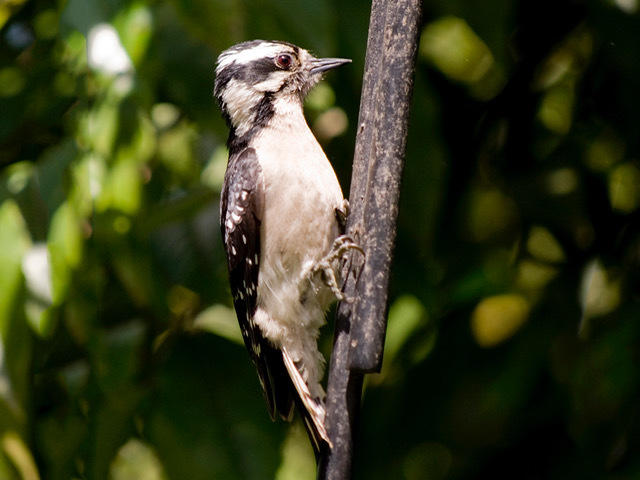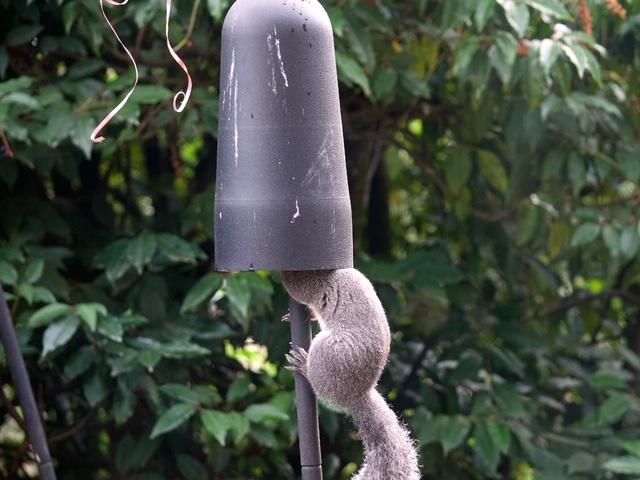Don't Oil Your Pole
Keeping Squirrels (& Other Pests) Off of Bird Feeders
By Dan Gleason
Oils on poles? NO! Please NEVER use oily or greasy products!
Squirrels are “professional climbers”! So, yes, they can easily climb your poles and they love your birdseed. So, if you hang your bird feeder on a hook from a pole, squirrels will certainly want to and try to climb the pole to reach the bird food.
 There are, however, many things that you can do to prevent squirrels from reaching or eating the bird food you provide. There are also some things that you should NOT do to prevent squirrels from climbing such poles. Let me begin with what NOT to do.
There are, however, many things that you can do to prevent squirrels from reaching or eating the bird food you provide. There are also some things that you should NOT do to prevent squirrels from climbing such poles. Let me begin with what NOT to do.
Many people use products such as Vaseline, WB-40, axle grease or another greasy or oily products, with the idea that this provides a slippery barrier that the squirrel can’t get past. At least initially, the animal slides down the pole while trying.
It may be effective and funny to watch, but please, do NOT do this. Such petroleum-based products can be harmful to animals. Squirrels that get these substances on their paws will clean themselves by licking and will thereby take these petroleum products in internally where they are potentially toxic. Small amounts ingested may act as a laxative but larger amounts can cause greater damage. Severe lung damage can occur if aspirated into the lungs. This seldom occurs but is possible. They can also be irritating and potentially cause damage if such products get into the eyes. Our desire is to prevent or discourage squirrels from reaching the bird food, not to cause them harm or to kill them!
One “solution” sometimes offered to this problem is the use of so-called “natural products,” usually soy or coconut oils. One such product is called Squirrel Slip. I suspect that this is safe for squirrels because the ingredients are not toxic.
However, I can NOT recommend the use of such products because they could cause potential harm to birds.
These “natural” oils are not naturally-occurring fats that wild birds would come in contact with to eat, but they are of a type that could be used by a bird’s metabolism so they are not toxic and safe if eaten. The danger is not from consumption, but from the physical damage that they can do to the feathers.
Birds often will land on metal poles (see photo) or they may brush their feathers against the pole when approaching the feeders. When this occurs, the oils in these products (as well as in the petroleum-based products) will be picked up by the feathers.
Once on the feathers, the feather can be damaged in a number of ways.
1. Oils cause the feathers to become matted down. Once that occurs, the feather will lose its ability to be water-proof and to provide insulating capability.
2. The matting of the feathers in the tail or wings will decrease the ability of the bird to fly efficiently or at all if enough feathers are involved. Keeping the body feathers in good condition provides an insulating barrier to keep the bird warm.
This may sound counter-intuitive at first. After all, aren’t oils from the preen gland naturally spread throughout the plumage during preening?
However, recall that oil spills, even small ones, are deadly to any birds that encounter them. Secretions from the preen gland are waxy, fatty secretions, but they provide no water-proofing. They help keep the feathers supple and in good condition in part by discouraging the growth of harmful bacteria and fungi that break down and digest keratin, the basic component of feathers. These preen gland secretions also promote the growth of bacteria and fungi that can provide protection to the feathers by discouraging harmful bacteria and fungi and by making it more difficult for feather lice to chew the feathers. Water-proofing is a property of some feathers due to its physical micro-structure, not added oils. Feathers in poor condition will lose the water-proofing ability. Adding oils to the feathers, whether natural or petroleum-based, can destroy these needed properties.
So, while soy and coconut oils are safe for birds to ingest, they can still cause unintended harm.
And birds DO land on metal poles, often grabbing them briefly en route to the feeder. In the included photo, a Downy Woodpecker has grabbed the pole and was slowly working her way up the pole to reach a suet feeder. All the while she climbed up, her tail and possibly her belly feathers, were coming in contact with the metal of the pole. If oils were on this pole, then the tips of the tail feathers or her belly feathers would quickly become soiled and potentially damaged. Damaged belly or breast feathers could destroy some of the insulating properties that undamaged feathers would provide. The tail feathers are very important, essential really, for a woodpecker as their strength helps them prop the bird up against the tree trunk.
If oils of any kind would be a problem for birds or other wildlife, what solutions ARE available to keep squirrels from your bird feeders?
The first option is to simply place the feeder out of reach from a squirrel.
Keep in mind that they can jump 8-10 feet from a branch to reach a feeder or even a longer distance if jumping from a branch above your feeder. They can jump vertically up from the ground 4-5 or more feet. This can make placing the feeder away from the squirrel’s reach something of a challenge. Here at Wild Birds Unlimited we can offer you some other solutions.
 To keep squirrels from climbing poles we have baffles that can be attached to a pole which physically provide a barrier that squirrels cannot pass, assuming proper placement. Remember, squirrels can jump so the baffle must be 5-6 feet above the ground or from any other object (like a bush or planter) to prevent jumping over it.
To keep squirrels from climbing poles we have baffles that can be attached to a pole which physically provide a barrier that squirrels cannot pass, assuming proper placement. Remember, squirrels can jump so the baffle must be 5-6 feet above the ground or from any other object (like a bush or planter) to prevent jumping over it.
If you don’t wish to use a baffle or you have a pole that a typical baffle will not fit onto, there are a variety of squirrel-proof feeders available for sale. Most of these have a mechanism that closes the feeding ports of the feeder when a squirrel sits on or grabs the feeders. The weight of the squirrel closes the port but birds are very light and do not weigh enough to close the feeding ports. Thus a bird can continue to feed at the feeder while the seed becomes unavailable to the heavier squirrel.
There is another solution, albeit a bit more expensive, initially at least. Wild Birds Unlimited now has seed available (hot pepper No Mess blend seed) that is coated with a strong extract of capsaicin, the “hot” part of hot peppers. Birds can taste this but show no aversion to it whatsoever. They lack a receptor found in mammals that causes an unpleasant or mildly painful experience. Thus, birds will continue to joyfully eat the seed while squirrels (or rats, bears or other mammals) will reject it once tasted.
In nature, peppers (not sweet peppers, but chili peppers) evolved to attract birds who will consume the seeds, eating them whole, and distribute the seeds to make more plants via their droppings. Mammals would destroy the seeds with their teeth which is of no use to the pepper plant. These peppers are usually red which attracts birds but is a warning to mammals that, if eaten, the results will be unpleasant. Humans are one of the few mammals that have learned to enjoy the “hotness” of the peppers. Our pepper-treated seed has a very strong level of capsaicin and can cause discomfort to the skin (the pain receptor are found throughout the body, not just in the mouth), but lower concentrations, like “pepper-flavor” are generally ineffective. The cost of producing such seed is expensive and only a couple of suppliers have the ability to do this (It requires a completely separate facility where all workers must wear protective clothing and masks), so this is usually a short-term solution and one I recommend to discourage rats, and it certainly works on squirrels.

